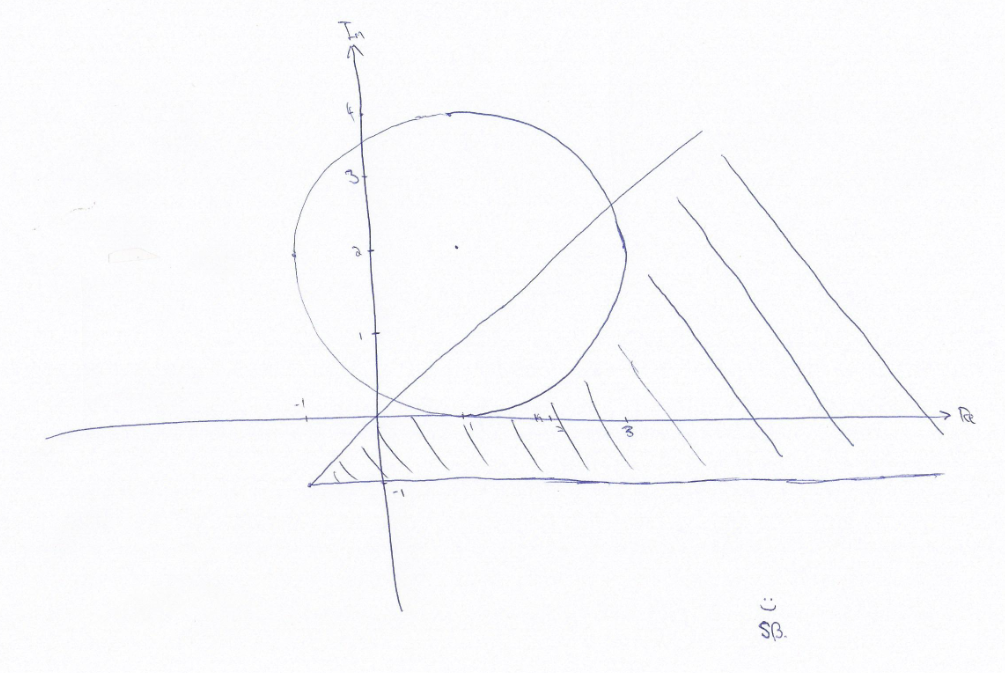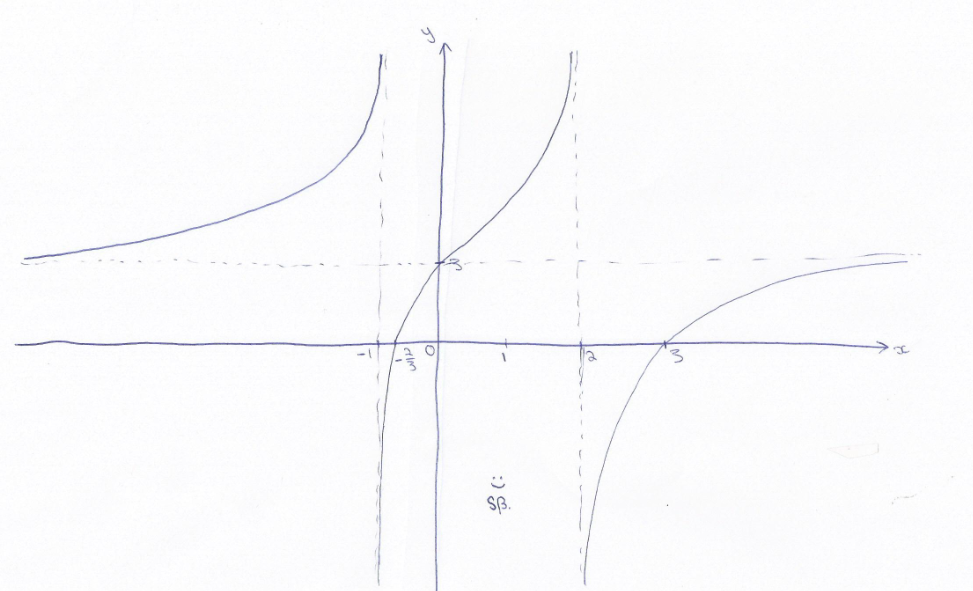OCR MEI - FP1 - 14th May 2015
Scroll to see replies
 Fixed it now.
Fixed it now.You were given the polynomial
And some information: the sum of the roots is 6, the product of the roots is -10, and one of the roots is 4. You had to find p, q and r.
How did you go about doing it??? I know I did it in the most convoluted way going.
You could get p and r immediately from the sum and product of the roots, and then I factorised the cubic (because (x - 4) was a factor) and deduced q from that.


I did the same as that except rather than factorising, i subbed in x=4 and made it equal to zero..
Also, 7ii is still incorrect as the second part of the inequality should be 0<=x<2 rather than 3<=x<2 !
Also, 7ii is still incorrect as the second part of the inequality should be 0<=x<2 rather than 3<=x<2 !
Sounds good.



I got those 2 yes but what I then did

and went from there... Do you think that's alright?

and went from there... Do you think that's alright?
Well I'm not sure about those upside down question marks.

So that gives you the third root, then what?
Posted from TSR Mobile

So that gives you the third root, then what?
Well it gives you the 2 roots then you add the 4 and multiply out. You have to put something in about beta and gamma being bi-variable and if one takes one value the other takes its complex congigate.
Ah, fair enough. It's a valid method, so as long as you got the right answer I'm sure it'll be accepted!
Good, that was scary.the answer is 3 right?
Nope, p = -12, q = 11, r = 20.
 Bad luck.
Bad luck. Bad luck.
Bad luck.Oh... Well I got the other 2 correct

Yeah can't lose 2 marks for getting it entirely right! Bullsh*t question, I didn't think I'd have to repeat the obvious lol
Posted from TSR Mobile
 Bad luck.
Bad luck.NUUUUUUU I got r=123 T.T
There were 2 r's in the paper.
O. Thanks that calmed my heart ..
Posted from TSR Mobile
:P yeah the other r was 123, don't worry
1.
2.
3.
4.

5i. Use standard summations.
ii.
6. Run-of-the-mill proof by induction.
7i. Sketch:

ii. Values of x for which are:
8i.
ii.
iii. , or
iv. or
9i. A'(0, 0), B'(-4, 0), C'(2, 12)
ii. Horizontal enlargement with s.f. 4, vertical enlargement with s.f. 2
iii. The matrix required was:
\dfrac{1}{48}\begin{pmatrix}[br]0 & 8 \\[br]-6 & 12[br]\end{pmatrix}
iv. 192 sq. units
Please marry me
BUT will i lose some marks for the argand diagram question because for the part where you had do draw the argument boundries i used dotted lines instead of solid?
BUT will i lose some marks for the argand diagram question because for the part where you had do draw the argument boundries i used dotted lines instead of solid?
probs 1 or 2 marks because it shows that the line wasn't inclusive of that inequality, and it clearly was. So it sort of shows you didn't understand the condition fully.
Quick Reply
Related discussions
- A-level Exam Discussions 2024
- A Level Exam Discussions 2023
- Predicted papers
- GCSE Exam Discussions 2024
- A level 2023 exams
- OCR A Level Mathematics B (MEI) Paper 2 (H640/02) - 11th June 2024 [Exam Chat]
- OCR
- OCR A Level Classical Civilisation Paper 1 (H408/11) - 14th May 2024 [Exam Chat]
- Further maths
- mega link for a level papers
- MEI numerical methods revision help
- Grade boundaries and grade allocations.
- Ocr mei 2023
- OCR MEI Paper 3 A Level Maths Predictions
- Any OCR MEI Comprehension tips?
- Need help on what to do to improve on my a levels!
- Edexcel Further Mathematics Mechanics Exam 14th June 2023 [Exam Chat]
- OCR
- Further Maths Gap Year
- Further Maths Modules
Latest
Last reply 1 minute ago
Can I get an A/A* using claire bio and ms estruch vids for OCR A level biologyLast reply 1 minute ago
Official London School of Economics and Political Science 2024 Applicant ThreadLast reply 8 minutes ago
Searching for a KCL Postgrad to take over my accommodation contractLast reply 9 minutes ago
TSR Study Together - STEM vs Humanities!Last reply 9 minutes ago
Official UCL Offer Holders Thread for 2024 entryLast reply 10 minutes ago
Weidenfeld Hoffmann Trust (WHT) Scholarship Notification (2024-2025)Last reply 10 minutes ago
ATAS (Academic, Technology, Approval Scheme) Certificate 2023/2024Last reply 11 minutes ago
yet to receive a woodhouse interviewLast reply 12 minutes ago
Government Social Research - Research Officer Scheme 2024Last reply 13 minutes ago
Official University of the Arts London Applicant Thread for 2024Last reply 14 minutes ago
National Probation ServiceLast reply 15 minutes ago
Official Veterinary Medicine Applicants thread 2024 entryLast reply 15 minutes ago
Official University College London Applicant Thread for 2024Trending
Last reply 1 day ago
Edexcel A Level Mathematics Paper 1 (9MA0 01) - 4th June 2024 [Exam Chat]Last reply 3 days ago
Edexcel IGCSE Higher tier Mathematics A Paper 1 1H (4MA1) - 8th November 2023Last reply 1 month ago
Edexcel GCSE Mathematics Paper 3 (1MA1 3) - 13th November 2023 [Exam Chat]Last reply 1 month ago
Edexcel GCSE Statistics Paper 1 Higher Tier (1ST0 1H) - 12th June 2023 [Exam Chat]284
Last reply 1 month ago
Edexcel A Level Mathematics Paper 1 (9MA0 01) - 6th June 2023 [Exam Chat]2960
Last reply 1 month ago
AQA A Level Mathematics Paper 1 (7357/1) - 6th June 2023 [Exam Chat]352
Last reply 1 month ago
Edexcel GCSE Mathematics Paper 2 (1MA1 2) - 10th November 2023 [Exam Chat]Last reply 2 months ago
Edexcel A-level Mathematics Paper 1 [6th June 2023] Unofficial Markscheme156
Last reply 2 months ago
Edexcel GCSE Mathematics Paper 1 (1MA1 1) - 8th November 2023 [Exam Chat]Last reply 3 months ago
Edexcel IGCSE Higher tier Mathematics A Paper 1 1H (4MA1) - 19th May 2023 [Exam Chat]232
Last reply 3 months ago
AQA GCSE Mathematics Paper 3 (Higher) 8300/3H - 14th June 2023 [ Exam Chat]247
Last reply 5 months ago
Edexcel IGCSE Higher tier Mathematics A Paper 2 2H (4MA1) - 10th November 2023Last reply 7 months ago
OCR A-level Mathematics A Paper 3 (H240/03) - 20th June 2023 [Exam Chat]169
Last reply 8 months ago
AQA Level 2 Further Maths 2023 Paper 1 (8365/1) & Paper 2 (8365/2) [Exam Chat]489
Last reply 8 months ago
Edexcel A Level Mathematics Paper 3 (9MA0 03) - 20th June 2023 [Exam Chat]1836
Last reply 8 months ago
AQA A Level Mathematics Paper 3 (7357/3) - 20th June 2023 [Exam Chat]307
Last reply 8 months ago
OCR A-level Mathematics B Paper 3 (H640/03) - 20th June 2023 [Exam Chat]132
Last reply 9 months ago
Edexcel A-level Further Mathematics Paper 1 (9FM0 01) - 25th May 2023 [Exam Chat]902
Trending
Last reply 1 day ago
Edexcel A Level Mathematics Paper 1 (9MA0 01) - 4th June 2024 [Exam Chat]Last reply 3 days ago
Edexcel IGCSE Higher tier Mathematics A Paper 1 1H (4MA1) - 8th November 2023Last reply 1 month ago
Edexcel GCSE Mathematics Paper 3 (1MA1 3) - 13th November 2023 [Exam Chat]Last reply 1 month ago
Edexcel GCSE Statistics Paper 1 Higher Tier (1ST0 1H) - 12th June 2023 [Exam Chat]284
Last reply 1 month ago
Edexcel A Level Mathematics Paper 1 (9MA0 01) - 6th June 2023 [Exam Chat]2960
Last reply 1 month ago
AQA A Level Mathematics Paper 1 (7357/1) - 6th June 2023 [Exam Chat]352
Last reply 1 month ago
Edexcel GCSE Mathematics Paper 2 (1MA1 2) - 10th November 2023 [Exam Chat]Last reply 2 months ago
Edexcel A-level Mathematics Paper 1 [6th June 2023] Unofficial Markscheme156
Last reply 2 months ago
Edexcel GCSE Mathematics Paper 1 (1MA1 1) - 8th November 2023 [Exam Chat]Last reply 3 months ago
Edexcel IGCSE Higher tier Mathematics A Paper 1 1H (4MA1) - 19th May 2023 [Exam Chat]232
Last reply 3 months ago
AQA GCSE Mathematics Paper 3 (Higher) 8300/3H - 14th June 2023 [ Exam Chat]247
Last reply 5 months ago
Edexcel IGCSE Higher tier Mathematics A Paper 2 2H (4MA1) - 10th November 2023Last reply 7 months ago
OCR A-level Mathematics A Paper 3 (H240/03) - 20th June 2023 [Exam Chat]169
Last reply 8 months ago
AQA Level 2 Further Maths 2023 Paper 1 (8365/1) & Paper 2 (8365/2) [Exam Chat]489
Last reply 8 months ago
Edexcel A Level Mathematics Paper 3 (9MA0 03) - 20th June 2023 [Exam Chat]1836
Last reply 8 months ago
AQA A Level Mathematics Paper 3 (7357/3) - 20th June 2023 [Exam Chat]307
Last reply 8 months ago
OCR A-level Mathematics B Paper 3 (H640/03) - 20th June 2023 [Exam Chat]132
Last reply 9 months ago
Edexcel A-level Further Mathematics Paper 1 (9FM0 01) - 25th May 2023 [Exam Chat]902




